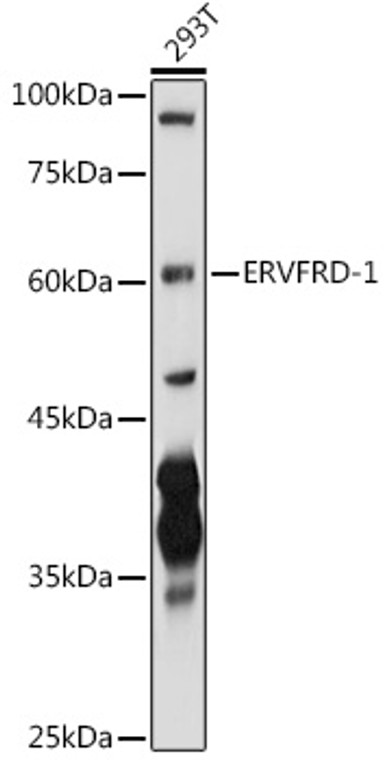| Host: |
Rabbit |
| Applications: |
WB |
| Reactivity: |
Human |
| Note: |
STRICTLY FOR FURTHER SCIENTIFIC RESEARCH USE ONLY (RUO). MUST NOT TO BE USED IN DIAGNOSTIC OR THERAPEUTIC APPLICATIONS. |
| Short Description: |
Rabbit polyclonal antibody anti-ERVFRD-1 (16-250) is suitable for use in Western Blot research applications. |
| Clonality: |
Polyclonal |
| Conjugation: |
Unconjugated |
| Isotype: |
IgG |
| Formulation: |
PBS with 0.02% Sodium Azide, 50% Glycerol, pH7.3. |
| Purification: |
Affinity purification |
| Dilution Range: |
WB 1:500-1:1000 |
| Storage Instruction: |
Store at-20°C for up to 1 year from the date of receipt, and avoid repeat freeze-thaw cycles. |
| Gene Symbol: |
ERVFRD-1 |
| Gene ID: |
405754 |
| Uniprot ID: |
SYCY2_HUMAN |
| Immunogen Region: |
16-250 |
| Immunogen: |
Recombinant fusion protein containing a sequence corresponding to amino acids 16-250 of human ERVFRD-1 (NP_997465.1). |
| Immunogen Sequence: |
AYRHPDFPLLEKAQQLLQST GSPYSTNCWLCTSSSTETPG TAYPASPREWTSIEAELHIS YRWDPNLKGLMRPANSLLST VKQDFPDIRQKPPIFGPIFT NINLMGIAPICVMAKRKNGT NVGTLPSTVCNVTFTVDSNQ QTYQTYTHNQFRHQPRFPKP PNITFPQGTLLDKSSRFCQG RPSSCSTRNFWFRPADYNQC LQISNLSSTAEWVLLDQTRN SLFWENKTKGANQSQ |
| Tissue Specificity | Expressed at higher level in placenta. Expressed at lower level in adrenal, bone marrow, brain, breast, colon, kidney, lung, ovary, peripheral blood lymphocytes, prostate, skin, spleen, testis, thymus, thyroid, trachea. |
| Post Translational Modifications | Specific enzymatic cleavages in vivo yield the mature SU and TM proteins. The CXXC motif is highly conserved across a broad range of retroviral envelope proteins. It is thought to participate in the formation of a labile disulfide bond possibly with the CX6CC motif present in the transmembrane protein. Isomerization of the intersubunit disulfide bond to an SU intrachain disulfide bond is thought to occur upon receptor recognition in order to allow membrane fusion. |
| Function | This endogenous retroviral envelope protein has retained its original fusogenic properties and participates in trophoblast fusion and the formation of a syncytium during placenta morphogenesis. The interaction with MFSD2A is apparently important for this process. Endogenous envelope proteins may have kept, lost or modified their original function during evolution but this one can still make pseudotypes with MLV, HIV-1 or SIV-1 virions and confer infectivity. Retroviral envelope proteins mediate receptor recognition and membrane fusion during early infection. The surface protein mediates receptor recognition, while the transmembrane protein anchors the envelope heterodimer to the viral membrane through one transmembrane domain. The other hydrophobic domain, called fusion peptide, mediates fusion of the viral membrane with the target cell membrane. |
| Protein Name | Syncytin-2Endogenous Retrovirus Group Frd Member 1Envelope PolyproteinHerv-FrdHerv-Frd_6p24.1 Provirus Ancestral Env Polyprotein Cleaved Into - Surface ProteinSu - Transmembrane ProteinTm |
| Cellular Localisation | VirionSurface Protein: Cell MembranePeripheral Membrane ProteinThe Surface Protein Is Not Anchored To The MembraneBut Localizes To The Extracellular Surface Through Its Binding To TmTransmembrane Protein: Cell MembraneSingle-Pass Membrane Protein |
| Alternative Antibody Names | Anti-Syncytin-2 antibodyAnti-Endogenous Retrovirus Group Frd Member 1 antibodyAnti-Envelope Polyprotein antibodyAnti-Herv-Frd antibodyAnti-Herv-Frd_6p24.1 Provirus Ancestral Env Polyprotein Cleaved Into - Surface Protein antibodyAnti-Su - Transmembrane Protein antibodyAnti-Tm antibodyAnti-ERVFRD-1 antibodyAnti-ERVFRDE1 antibodyAnti-UNQ6191 antibodyAnti-PRO20218 antibody |
Information sourced from Uniprot.org
12 months for antibodies. 6 months for ELISA Kits. Please see website T&Cs for further guidance







